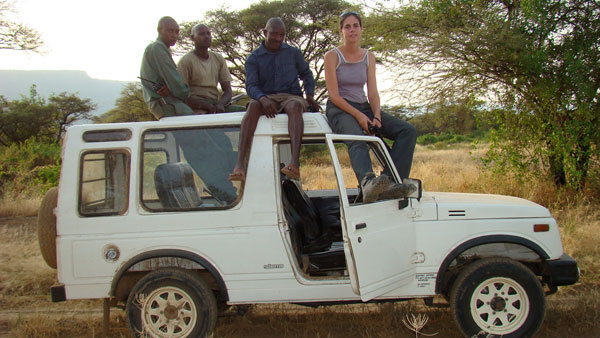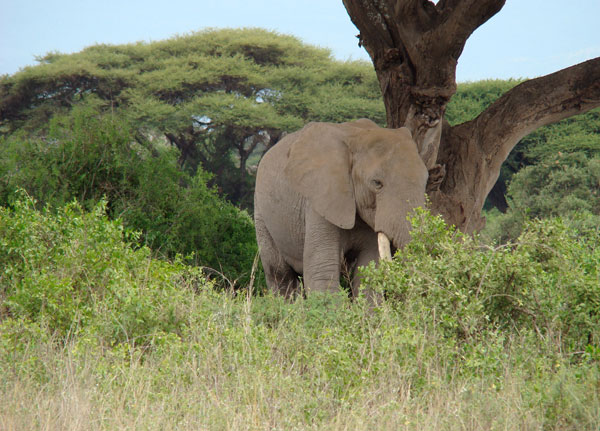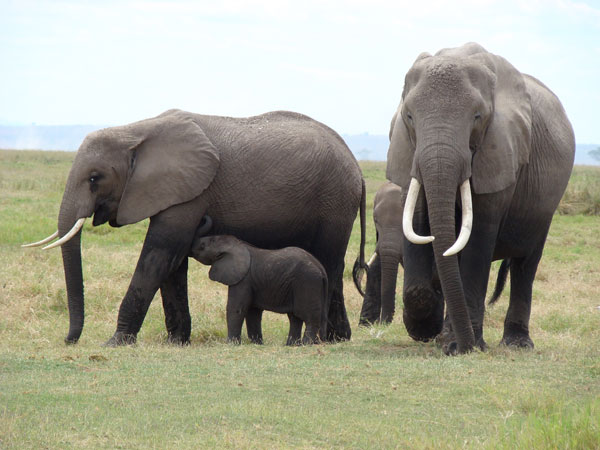In a thick pocket of acacia trees, a group of savannah elephants quietly munch leaves. Tails swing, ears flip and flap. Occasionally one scoops up a trunk full of dirt and tosses it across its face and back, to cool the hide and displace insects.
A few yards away, 3 researchers crouch in the brush, watching and filming. The setting seems peaceful and quiet, but the researchers are tensely aware: wild elephants can charge if frightened or startled. And the last thing a scientist wants is to be charged by the largest land animal in the world — especially while in pursuit of its poop.
Yes, poop.
“We needed fresh dung in order to gather DNA material,” explains grasslands ecologist Marissa Ahlering of The Nature Conservancy. But what for? While collecting dung samples from wild elephants is somewhat dangerous and far from glamorous (see video), the work has been providing useful insight into whether elephant populations in Kenya could live in proximity to people and livestock without stress.
Using advanced genetic testing techniques to analyze stress hormones extracted from the dung samples, Ahlering has been able to show that elephants will colonize community conservation areas (CCAs) — places established outside of parks for both people and wildlife to coexist — without elevated levels of stress compared to elephants in nearby protected areas.
With the huge threats elephants face — ivory poaching has wiped out their populations across Africa — could CCAs help them rebound? Ahlering’s research, funded by the Smithsonian Institution and the University of Missouri, signals real possibility that such areas could meet the needs of elephants and help in their recovery.
To Track an Elephant

Ahlering was a post-doctoral student in 2007 and 2008 when she traveled to Kenya to study elephant re-colonization. A grasslands ecologist, she says she didn’t know anything about elephant tracking before this project — but she did bring something extremely valuable to the work: knowledge of the latest genetic technologies.
Genetic testing has improved by leaps and bounds in the past 10 years, providing scientists with new opportunities to study animals in the wild. But it can be expensive, and collecting quality samples is challenging.
“It takes specialized techniques to extract a DNA sample from dung, ” says Ahlering. “But it is being used more often, particularly for large elusive animals like elephants, tigers and nocturnal animals.
The dung needed to be fresh in order to provide the highest quality sample. Ahlering hired local Maasai people to help. The team clocked dozens of hours in the field, trailing behind elephants to collect dung less than 12 hours old (see video). She also brought along armed rangers for safety.
“We had a few scary incidents. At one point we got between a group of female [elephants] in front of us and a group of males that we didn’t know were behind us. Everyone ran at first, then one of the rangers fired shots into the air to scare off the elephants,” says Ahlering.
All told, they collected samples from 168 elephants. The DNA extracted from the dung showed that most of the elephants in the recolonized CCA came from nearby Maasai Mara and Serengeti National Parks — a finding that Ahlering published in 2012 in PLOS ONE.
“We didn’t know if elephants would use these community conservation areas outside of parks — now we know they will,” she explains.

To assess stress, she compared levels of glucocorticoid (a hormone that increases with stress) from the dung samples of 3 different elephant groups: from the CCA, and from 2 adjacent protected areas, Amboseli and Maasai Mara National Parks. While elephants in the 27,000-hectare CCA — established for wildlife conservation, ecotourism and grazing by Maasai pastoralists in times of drought — are exposed to people, agriculture and livestock on a daily basis, the elephants in the national parks are only exposed to people through limited ecotourism and research.
“We wanted to know, does an elephant experience stress when living in close proximity to human settlements?” she explains. “You would think the answer would be yes, but we didn’t find that to be true.”
She recently published her findings in the journal Conservation Biology. Her analyses showed that the stress levels of elephants in the CCA were the same as elephants in the protected area of Maasai Mara. Interestingly, elephants at Amboseli exhibited lower stress hormones than the other two groups — a finding that Ahlering says could be due to genetic differences or other variables, but needs more research to fully understand.
“Measuring stress hormones is fairly controversial,” says Ahlering. “Some scientists think you can’t interpret anything from the results, others think you can.”
While genetic testing technology has improved in recent years, researchers can’t measure basal stress levels — which means any measurement taken is only an indication of the level of stress at that moment in time. And there can be high variability in the findings. Another study, using different hormone analysis techniques, showed findings contrary to Ahlering’s — that elephants outside parks experience more stress than those inside.
A Way for Elephants to Come Back?

However, as Ahlering and her co-authors write in their paper, the fact that they did not find clear evidence of chronic stress in elephants living on the CCA “is encouraging for conservation strategies promoting the protection of animals living outside protected areas.”
“Elephants are confined to protected areas now, due to the high threats they face,” says Ahlering. “Protected areas are key and in some places are helping increase elephant populations, but it’s necessary for elephants to have places to move to from the parks.”
These threats are tragically displayed across the news, with gruesome headlines and photos depicting elephant slaughter by ivory poachers. Ivory poaching is a decades-old problem that continues to rise despite a global ban instituted in 1989. In Kenya, elephant populations were decimated by poaching in the 1970s and 1980s and are only now beginning to come back within protected areas. But even within protected parks, elephants are not always safe.
African elephants face a highly uncertain future. While solving the poaching problem largely comes down to policy changes, Ahlering’s work could play a role in helping guide a more hopeful future for elephants.
“This research does help conservationists figure out how to establish viable populations again,” she says. “And unfortunately, we’ll need to know that.”
You can learn more about Ahlering’s stress hormone research here or download the full study (subscription required).



Join the Discussion
1 comment